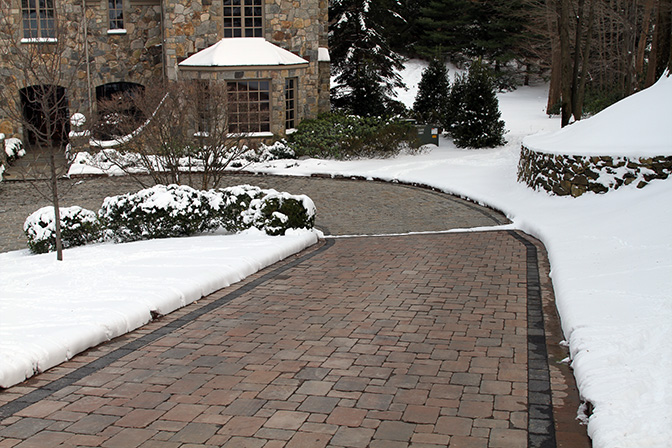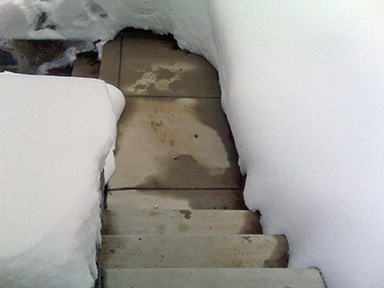The Joy of Winter
Keeping driveways and walks clear of snow and ice during the winter months is never any fun. While homeowners shovel their driveway and walks for convenience and added safety, snow removal is an absolute necessity for business owners. Keeping the premises safe – and inviting – for prospective customers is vital to their businesses.
While some business owners pay a snow removal service or task employees to shovel and salt the walks and parking areas, many are turning to automated snow melting systems. These radiant snow melting systems are maintenance free, and can keep entire areas clear of snow and ice 24/7.
Heated driveway systems are designed to activate as the first snowflake falls. When precipitation is detected and the temperature is below a designated set point (usually 38 or 39 degrees), the sensor signals the snow melting system’s controller, and power is then sent to the embedded heating cable. The heating element quickly warms the driveway (or sidewalk, steps, ramp, etc.) to prevent snow from accumulating.
As an industry-leading provider and designer of radiant snow melting systems, Warmzone utilizes the trusted ClearZone heating cable. The cable can be embedded in concrete, installed under pavers, and even in hot asphalt applications. The cable is available in custom lengths off the spool or pre-spaced in easy-to-install mats. The mats feature cable in 3- and 4- inch spacing (and custom spacing upon request). The ClearZone heating mats can be quickly rolled out and secured over the area to be heated, and then embedded in concrete, asphalt, or pavers. The mats facilitate the installation and ensure proper cable spacing.

Heated Driveway Retrofit
In addition to installing radiant heat in new construction applications, existing driveways can also be retrofitted with radiant heat. For example, in a concrete driveway, saw-cut technology can be used to create channels in the driveway, whereby heat cable is then inserted. An epoxy topcoat is then applied to seal the cable, allowing consumers to enjoy the benefits of a heated driveway at relatively little cost. For added traction and safety, a sand broadcast can be applied to the surface before the epoxy cures if desired.
Asphalt driveways can also be easily retrofitted with radiant heat. ClearZone heat cable is laid out over the existing driveway, and a fresh layer of asphalt is then applied. This is a popular option for homeowners with asphalt driveways.
Each Warmzone driveway heating system is designed according to ASHRAE standards. This ensures that every system is customized specifically to meet the weather conditions and snow melting demands of the customer. Average snowfall and temperatures, and other factors specific to the locale are taken into consideration. For example, a heated driveway in Tehachapi, California will be different from one designed for Juno, Alaska.
Fully Automated and Efficient
Radiant snow melting systems efficiently operate only when needed. However, after the snowstorm, the system is designed to remain on for a short time to dry the surface area so that no black ice develops. This added safety feature is a Godsend to business owners, keeping parking areas, walkways, and entryways free of thin sheets of slick ice.
In addition to eliminating the costs associated with manual snow removal, automated snow melting systems ensure that when business opens in the morning after an unexpected snowstorm, the sidewalks, loading docks, ramps, etc., will be clear. Customers will have a safe, clear entryway to the business.
Industry Leading Support Services
What sets Warmzone apart from other radiant heat providers is its preeminent customer services. That’s why professional installers continue to work with Warmzone for their radiant heating needs. In addition to receiving free installation training from Warmzone, installers are also assured of receiving installation support if needed during the install. Warmzone has a designated staff of experts who are tasked with assisting installers in the field.
Warmzone also houses a professional radiant heat system design staff. Our experienced designers carefully evaluate each radiant heating system and create a detailed CAD layout of the ideal system. The drawing includes the proper materials and layout of the heating element and components, as well as the proper load calculations, breaker sizes, and number of breakers. This gives the electrician and installers all the information necessary to proceed with a successful installation prior to one foot of heat cable being installed.
Warmzone representatives are also available to answer any questions you may have. If you’re interested in radiant heat, call and speak with a friendly expert today at 888.488.9276.

